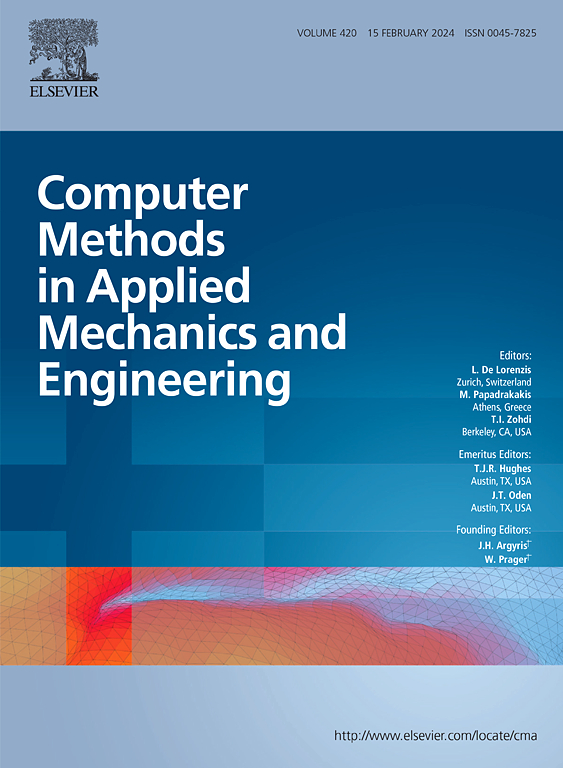The rationality of using dynamic relaxation method for failure simulation in peridynamics
IF 6.9
1区 工程技术
Q1 ENGINEERING, MULTIDISCIPLINARY
Computer Methods in Applied Mechanics and Engineering
Pub Date : 2025-02-24
DOI:10.1016/j.cma.2025.117847
引用次数: 0
Abstract
In peridynamics, a large amount of research related to material failure has applied the dynamic relaxation (DR) method under static or quasi-static loading conditions. However, as a pseudo-dynamic method that converts static problems into dynamic problems by introducing fictitious inertia and damping terms, the intermediate attenuation process of the DR method is not realistic. Whether it is truly suitable for simulating the irreversible mechanical behavior of material failure, which closely depends on the real process and has significant dynamic effects in the later stage of failure, is still a debatable issue. This article first derives the prerequisite for applying the DR method to solve static or quasi-static problems, which is to ensure that the load and system stiffness remain constant during the solving process. However, material damage will inevitably weaken the stiffness of the system and break this prerequisite. In view of this, using explicit dynamic algorithm for failure simulation is worthy of being reconsidered. Secondly, the DR method is used to simulate the failure of l-shaped concrete specimen, and it is found that selecting different fictitious damping coefficients may lead to different crack propagation paths, resulting in uncertainty in the simulation results. It is also found that due to the use of fictitious damping in the DR method to suppress the acceleration effect in the accelerated failure stage, the dynamic effect of the system is not fully utilized, which leads to distortion of simulation results. At last, a two-stage joint algorithm is proposed suitable for material failure problems under static or quasi-static loading conditions. The DR method is only applied to the continuous deformation stage of materials without any damage, while the explicit dynamic algorithm is applied to the crack initiation and propagation stage after damage occurs. The numerical examples illustrate the effectiveness of the joint algorithm.
在周动力学中,大量与材料破坏相关的研究都采用了静态或准静态加载条件下的动态松弛(DR)方法。然而,作为一种通过引入虚构惯性和阻尼项将静态问题转化为动态问题的伪动态方法,DR 法的中间衰减过程并不真实。材料失效的不可逆力学行为与真实过程密切相关,并在失效后期具有显著的动态效应,DR 法是否真正适合模拟材料失效的不可逆力学行为仍是一个值得商榷的问题。本文首先推导出应用 DR 方法求解静态或准静态问题的前提条件,即确保求解过程中载荷和系统刚度保持不变。然而,材料损坏将不可避免地削弱系统刚度,从而打破这一前提条件。有鉴于此,使用显式动态算法进行失效模拟值得重新考虑。其次,利用 DR 方法模拟 l 型混凝土试件的破坏,发现选择不同的虚阻尼系数可能会导致不同的裂缝扩展路径,从而导致模拟结果的不确定性。研究还发现,由于 DR 方法中使用了虚阻尼来抑制加速破坏阶段的加速度效应,系统的动态效应没有得到充分利用,导致模拟结果失真。最后,提出了一种适用于静态或准静态加载条件下材料失效问题的两阶段联合算法。DR 方法仅适用于无任何损伤的材料连续变形阶段,而显式动态算法则适用于发生损伤后的裂纹萌发和扩展阶段。数值示例说明了联合算法的有效性。
本文章由计算机程序翻译,如有差异,请以英文原文为准。
求助全文
约1分钟内获得全文
求助全文
来源期刊
CiteScore
12.70
自引率
15.30%
发文量
719
审稿时长
44 days
期刊介绍:
Computer Methods in Applied Mechanics and Engineering stands as a cornerstone in the realm of computational science and engineering. With a history spanning over five decades, the journal has been a key platform for disseminating papers on advanced mathematical modeling and numerical solutions. Interdisciplinary in nature, these contributions encompass mechanics, mathematics, computer science, and various scientific disciplines. The journal welcomes a broad range of computational methods addressing the simulation, analysis, and design of complex physical problems, making it a vital resource for researchers in the field.

 求助内容:
求助内容: 应助结果提醒方式:
应助结果提醒方式:


